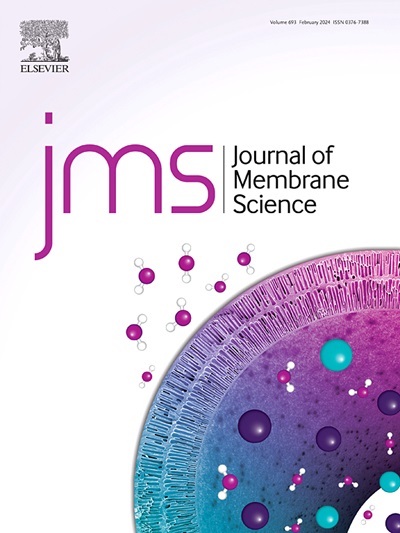Ultrafast fabrication of uniform nanoporous α-alumina membranes by photothermal-enhancing
IF 8.4
1区 工程技术
Q1 ENGINEERING, CHEMICAL
引用次数: 0
Abstract
Ceramic ultrafiltration membranes have attracted significant attention in bioproduct manufacturing due to their excellent biocompatibility and durability. However, traditional fabrication process involves high temperatures and prolonged heat treatments, which results in grain growth, particle sintering, and pore coalescence, eventually affecting separation efficiency. This study proposes an ultrafast fabrication method through the photothermal-enhanced rapid thermal process. By doping alumina sol with iron element, light-absorbing intensity can be increased by 7–21 times, significantly enhancing its photothermal effect under near-infrared radiation and shortening the heat treatment cycle. Additionally, the α-Fe2O3 formed during calcination promoted α-Al2O3 transition via a heterogeneous nucleation mechanism, effectively suppressing grain growth and sintering. Under optimized conditions —a heat treatment cycle of 115 s and a temperature of 850 °C—α-Al2O3 tight ultrafiltration membranes were rapidly fabricated. The membrane exhibited a dextran molecular weight cutoff (MWCO) of 13.9 kDa and a pure water permeability of 220 LMH/bar. In enzyme-membrane coupling tests, the membrane demonstrated precise permeation of bioactive peptides with molecular weights between 200 and 1700 Da (>98 wt%) while retaining peptides with molecular weights exceeding 2200 Da.
光热增强法制备均匀纳米多孔α-氧化铝膜
陶瓷超滤膜以其优异的生物相容性和耐久性在生物制品制造中引起了广泛的关注。然而,传统的制备工艺涉及高温和长时间的热处理,导致晶粒生长、颗粒烧结和孔隙聚结,最终影响了分离效率。本研究提出了一种利用光热增强快速热过程的超快制备方法。在氧化铝溶胶中掺入铁元素,可使其吸光强度提高7-21倍,显著增强了近红外辐射下的光热效应,缩短了热处理周期。此外,煅烧过程中形成的α-Fe2O3通过非均相成核机制促进α-Al2O3的转变,有效抑制晶粒生长和烧结。在热处理周期为115 s、温度为850℃的优化条件下,快速制备了α- al2o3致密超滤膜。该膜的葡聚糖分子量截断(MWCO)为13.9 kDa,纯水渗透率为220 LMH/bar。在酶-膜偶联测试中,膜显示出分子量在200至1700 Da之间(98% wt%)的生物活性肽的精确渗透,而保留分子量超过2200 Da的肽。
本文章由计算机程序翻译,如有差异,请以英文原文为准。
求助全文
约1分钟内获得全文
求助全文
来源期刊

Journal of Membrane Science
工程技术-高分子科学
CiteScore
17.10
自引率
17.90%
发文量
1031
审稿时长
2.5 months
期刊介绍:
The Journal of Membrane Science is a publication that focuses on membrane systems and is aimed at academic and industrial chemists, chemical engineers, materials scientists, and membranologists. It publishes original research and reviews on various aspects of membrane transport, membrane formation/structure, fouling, module/process design, and processes/applications. The journal primarily focuses on the structure, function, and performance of non-biological membranes but also includes papers that relate to biological membranes. The Journal of Membrane Science publishes Full Text Papers, State-of-the-Art Reviews, Letters to the Editor, and Perspectives.
 求助内容:
求助内容: 应助结果提醒方式:
应助结果提醒方式:


